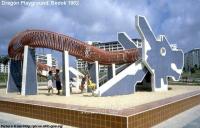Originally called the Hill Street Police Station and Barracks, the majestic six-storey Neoclassical-style colonial building was Singapore’s largest government building when it was completed at a cost of about $634,000 in 1934. It was dubbed by the British as one of the finest police barracks in the world.

Former Landmarks
Old Hill Street Police Station is located at the junction of Hill Street and River Valley Road and at the foot of Fort Canning Hill. Singapore’s first prison and the Assembly Hall (also known as Assembly Rooms) formerly occupied this site in the 19th century.
The Assembly Hall started as an attap and wooden house, built for public functions as Singapore’s first town hall. In 1858, it held one of the colony’s most elaborate ceremonies, when the Knight Commander of the Bath (KCB) was bestowed on James Brooke, the “White Rajah of Sarawak”. A new Town Hall was later built in 1862 at Empress Place. The Victoria Memorial Hall was added to the Town Hall in 1905, and the building has become known as the Victoria Theatre and Concert Hall today.
Early Police Stations
The first police office was a wooden shack built by convicts in 1821 near the present-day Anderson Bridge. Other police stations before 1880s were mostly timber buildings with unstable foundations.
In the late 1920s, Harold Fairburn (1884-1973), the Inspector-General of the Straits Settlements Police Force from 1925 to 1935, pushed for the construction of modern police stations in Singapore. He studied police requirements, crafted proposals and sought funds and approval from the colonial government.

Due to Harold Fairburn’s efforts, new concrete police stations were erected by the Public Works Department (PWD) between 1931 and 1936, including the Central Police Station, Beach Road Police Station and Barracks, Traffic Police’s branch at Maxwell Road and Sikh Police Barracks at Pearl’s Hill.
But the largest would be the Hill Street Police Station and Barracks, completed and officially opened in 1934. It was designed by Frank Dorrington Ward (1885-1972), Singapore’s Government Architect from 1928 to 1939, whose impressive portfolio included the Volunteers Headquarters, Clifford Pier, former Supreme Court building (present-day National Gallery Singapore), former Custom House and the terminal building of the former Kallang Airport.
Largest Police Station
The huge Hill Street Police Station and Barracks, designed with offices, garages, two prison cells and three electric lifts, could house 1,000 working personnel. The building also had bunks, kitchens and even badminton courts to meet the accommodation and recreational needs of the hundreds of policemen and their families staying at the police station between the 1930s and 1950s.
There was also the Singapore Police Creche, a nursey located at the top floor of police station. It served as a temporary home for the children of the policemen when they were outstationed or away for duties. Necessary medical care was also provided for those with sick and undernourished kids.

The nursery, headed by the Lady Medical Officer of the Police Force, was said to be one of its only kind in the Far East. During the Second World War, however, the Singapore Police Creche’s medical equipment, cots, beds and toys were looted by the Japanese.
Warning Sirens
The late 1930s saw increased international tensions throughout Europe and Asia. In Singapore, the colonial government carried out civil defence exercises in March 1939, simulating air raids and naval attacks of the island. A total of eight air raid warning sirens were installed at Hill Street Police Station, Orchard Road Police Station, Kandang Kerbau Police Station, Kallang Airport, Geylang Fire Station, Keppel Harbour and a garrison school at Mount Faber.
After the war, in 1958, another new air raid warning siren was installed and tested at Hill Street Police Station.
Japanese Occupation
The Hill Street Police Station, like many other government buildings, was taken over by the Japanese during the occupation. The offices and prison cells were rumoured to be used by the Kempeitai (Imperial Japanese Army’s military police) for interrogation and torture of the anti-Japanese personnel.
In 1943, the Japanese painted the Hill Street Police Station in dark brown shades, in order to camouflage the building against the Allied Forces’ air raids. After war, in 1949, the British repainted the building with new pearly white coats of paint, to signify a new era after Singapore’s darkest period in history.

Post-War Period
The Arms and Explosive Branch moved to Hill Street Police Station in 1949. It was the department that issued licenses to the private gun owners between the fifties to seventies.
In the fifties and sixties, audacious cases of robberies and fights between secret society members just outside the Hill Street Police Station were not uncommon.

Hill Street Police Station underwent a $500,000 renovation project in 1971. More than just a functioning office for the police force, the building then also housed numerous police-affiliated organisations such as the Police Junior Officers’ Association, Junior Officers’ Mess, Junior Officers’ Non-Muslim Benevolent Society, Lembaga Khairat Muslim (Muslim Benevolent Society) and the Police Cooperative and Loan Society.
In the seventies, urban renewals were carried out at many parts of Singapore’s downtown and city areas. In 1977, the Whampoa Ice House, a 123-year-old godown opposite of Hill Street Police Station, was demolished to make way for the widening of River Valley Road. The ice house, built by Ho Ah Kay in 1854, had been a prominent landmark in the vicinity for more than a century.

Hill Street Police Station was also a demolition target in the late seventies. Fortunately, in 1983, it was included in the Preservation of Monuments Board’s list of buildings, bridges, statues and monuments that merit preservation.
The police force vacated Hill Street Police Station by the end of the seventies. As the building no longer functioned as a police station, Hill Street Police Station was renamed Hill Street Building in 1980.


In the following decade, various agencies from the civil and public services moved into the building, including Board of Film Censors, Public Trustee’s Office, Official Receiver, Official Assignee, Display and Distribution Unit, Prison Welfare Service, and the National Archives and Records Centre (became National Archives and Oral History Department in 1981 and National Archives of Singapore in 1993).
The National Archives of Singapore stayed at Hill Street Building until 1997 as its last tenant.


Hill Street Building was gazetted as a national monument on 18 December 1998. It was given a $82-million facelift to convert the building into an arts centre, as well as offices for the Ministry of Information and The Arts (MITA) and its related statutory boards such as National Arts Council, National Heritage Board, Singapore Broadcasting Authority and Singapore International Foundation.
The major facelift also gifted the building its iconic appearance today. In 1999, the former police station building’s dull and stern image was instantly transformed when its 927 windows were painted with a riot of bright yellow, tangerine, red, green, blue and purple. On 1 November 2000, the reburbished building was officially reopened as MITA Building.

The opening of MITA Building would place MITA strategically opposite of The Treasury at High Street, which housed the Ministry of Trade and Industry, Ministry of Law, Ministry of Finance and Ministry of Foreign Affairs.
MITA absorbed the information technology function from the Ministry of Communications and Information Technology in 2001 and became the Ministry of Information, Communications and the Arts (MICA). Three years later, in 2004, MITA Building was renamed MICA Building.

In 2012, MICA was restructured to become part of the Ministry of Communications and Information (MCI) and Ministry of Culture, Community and Youth (MCCY). As it might be too difficult to remember the building’s name carrying the acronyms of the two ministries, it was decided that MICA Building would be renamed Old Hill Street Police Station.
A summary of the changes in the building’s name throughout the decades:
|
Name |
Years |
Remarks |
|
|
1 |
Hill Street Police Station and Barracks |
1934-1960s |
Officially opened in 1934. |
|
2 |
Silver Jubilee Building |
1935 |
Briefly renamed in 1935 as a commemoration for the 25th anniversary of King George V’s reign. |
|
3 |
Hill Street Police Station |
1960s-1980 |
Policemen housed in the building were gradually relocated to other accommodation in Singapore. |
|
4 |
Hill Street Building |
1980-2000 |
The police force moved out of the building in 1980. |
|
5 |
MITA Building |
2000-2004 |
Home to the Ministry of Information and The Arts (MITA). |
|
6 |
MICA Building |
2004-2012 |
MITA was renamed Ministry of Information, Communications, and the Arts (MICA). |
|
7 |
Old Hill Street Police Station |
2012-Present |
Reverted to its original name after MICA was restructured to become part of Ministry of Communications and Information (MCI) and Ministry of Culture, Community and Youth (MCCY). |
Published: 30 June 2024
Discover more from Remember Singapore
Subscribe to get the latest posts sent to your email.








Great write up! Another informative essay on an iconic building that many recognizes but knows little about. Wonderful job RemSG!
I worked there during around 2012 as an MICA officer. Nice building, gotta park at the nearby Clarke Quay carpark and walk over if I drive. Eat lunch at Liang court.
Mu uncle owns a printing shop across this building now has been demolished.
I used to go to his shop to take some part time work and many of the criminal of that day feared the building as it was a place where they were rounded and tortured to admit their crimes. The history of this building of the site has holds the wonder ‘Fung Sui’ of a dragon mouth ready to swallow that the criminal believed of their fate once entering to corridors of this building